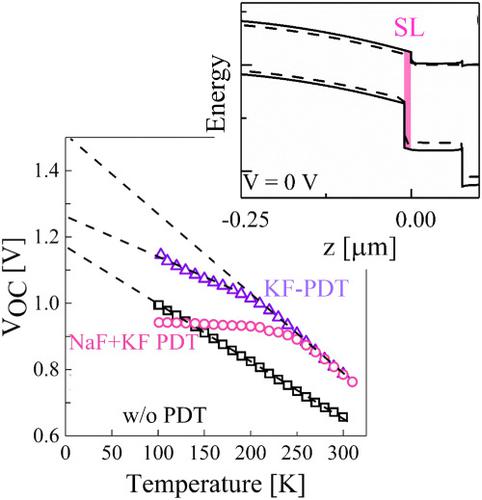当前位置:
X-MOL 学术
›
Prog. Photovoltaics
›
论文详情
Our official English website, www.x-mol.net, welcomes your feedback! (Note: you will need to create a separate account there.)
Effect of Na‐PDT and KF‐PDT on the photovoltaic performance of wide bandgap Cu (In,Ga)Se2 solar cells
Progress in Photovoltaics ( IF 6.7 ) Pub Date : 2020-08-11 , DOI: 10.1002/pip.3317 Setareh Zahedi‐Azad 1 , Matthias Maiberg 1 , Roland Scheer 1
Progress in Photovoltaics ( IF 6.7 ) Pub Date : 2020-08-11 , DOI: 10.1002/pip.3317 Setareh Zahedi‐Azad 1 , Matthias Maiberg 1 , Roland Scheer 1
Affiliation

|
Cu (In,Ga)Se2 solar cells exhibit higher efficiencies if an appropriate Ga gradient is introduced and if the absorber is doped with sodium (Na) plus a heavier alkali atom such as potassium. However, a Gallium gradient in the presence of Na is challenging because sodium impedes the interdiffusion of elements and influences the gradient. In this contribution, we show that the presence of sodium during growth with the combination of high Ga concentration creates a pronounced gradient that is detrimental for carrier collection. One solution is to avoid Na abundance during absorber growth but to add it to the grown absorber layer via a postdeposition treatment. We investigate the effect of different Na incorporation methods simultaneously with KF‐PDT on wide band gap CIGSe absorbers. By preparation on alkali‐free substrates and application of alkalis (NaF and KF) onto a grown CIGSe layer, we show by smoothening of the Gallium gradient a large improvement in the solar cell performance from 4% to 8%. Another way to optimize the gradient in the presence of Na is the modification of the three‐stage method. This yields the best efficiency of 10% in our laboratory at an integral GGI of ~0.8. By means of temperature‐dependent JV measurements, we show that the additional postdeposition of KF induces a barrier for the diode current. We conclude that KF‐PDT induces a new thin layer at the CIGSe surface that has a lower valence band edge relative to the CIGSe bulk and is responsible for the double‐diode behavior. This barrier can also explain the Voc(T) saturation at low temperature.
中文翻译:

Na‐PDT和KF‐PDT对宽带隙Cu(In,Ga)Se2太阳能电池光伏性能的影响
铜(铟,镓)硒2如果引入适当的Ga梯度,并且吸收剂中掺有钠(Na)以及较重的碱原子(如钾),则太阳能电池将具有更高的效率。但是,在钠存在下的镓梯度具有挑战性,因为钠会阻碍元素的相互扩散并影响梯度。在这一贡献中,我们表明,在生长过程中钠的存在与高Ga浓度的结合会产生明显的梯度,这对载体的收集有害。一种解决方案是在吸收体生长期间避免Na丰度,而是通过后沉积处理将其添加到生长的吸收体层中。我们研究了不同的Na掺入方法与KF‐PDT同时对宽带隙CIGSe吸收剂的影响。通过在无碱基材上进行制备并将碱(NaF和KF)施加到生长的CIGSe层上,我们可以通过平滑镓梯度显示出太阳能电池性能从4%大幅提高到8%。在Na存在下优化梯度的另一种方法是对三步法的修改。这在我们的实验室中的总GGI为〜0.8时可产生10%的最佳效率。通过与温度有关的JV测量,我们表明,KF的额外后沉积会引起二极管电流的势垒。我们得出的结论是,KF-PDT在CIGSe表面诱导出一个新的薄层,该薄层的价带边缘相对于CIGSe整体而言较低,并且是双二极管行为的原因。这个障碍也可以解释 通过平滑镓梯度,我们显示出太阳能电池性能从4%大幅提高到8%。在Na存在下优化梯度的另一种方法是对三步法的修改。这在我们的实验室中的总GGI为〜0.8时可产生10%的最佳效率。通过与温度有关的JV测量,我们表明,KF的额外后沉积会引起二极管电流的势垒。我们得出的结论是,KF-PDT在CIGSe表面诱导出一个新的薄层,该薄层的价带边缘相对于CIGSe整体而言较低,并且是双二极管行为的原因。这个障碍也可以解释 通过平滑镓梯度,我们显示出太阳能电池性能从4%大幅提高到8%。在Na存在下优化梯度的另一种方法是对三步法的修改。这在我们的实验室中的总GGI为〜0.8时可产生10%的最佳效率。通过与温度有关的JV测量,我们显示出额外的KF后沉积会为二极管电流产生势垒。我们得出的结论是,KF-PDT在CIGSe表面诱导出一个新的薄层,该薄层的价带边缘相对于CIGSe整体而言较低,并且是双二极管行为的原因。这个障碍也可以解释 这在我们的实验室中的总GGI为〜0.8时可产生10%的最佳效率。通过与温度有关的JV测量,我们表明,KF的额外后沉积会引起二极管电流的势垒。我们得出的结论是,KF-PDT在CIGSe表面诱导出一个新的薄层,该薄层的价带边缘相对于CIGSe整体而言较低,并且是双二极管行为的原因。这个障碍也可以解释 这在我们的实验室中的总GGI为〜0.8时可产生10%的最佳效率。通过与温度有关的JV测量,我们表明,KF的额外后沉积会引起二极管电流的势垒。我们得出的结论是,KF-PDT在CIGSe表面诱导了一个新的薄层,该薄层的价带边缘相对于CIGSe整体而言较低,并且是双二极管行为的原因。这个障碍也可以解释低温下oc(T)饱和。
更新日期:2020-10-05
中文翻译:

Na‐PDT和KF‐PDT对宽带隙Cu(In,Ga)Se2太阳能电池光伏性能的影响
铜(铟,镓)硒2如果引入适当的Ga梯度,并且吸收剂中掺有钠(Na)以及较重的碱原子(如钾),则太阳能电池将具有更高的效率。但是,在钠存在下的镓梯度具有挑战性,因为钠会阻碍元素的相互扩散并影响梯度。在这一贡献中,我们表明,在生长过程中钠的存在与高Ga浓度的结合会产生明显的梯度,这对载体的收集有害。一种解决方案是在吸收体生长期间避免Na丰度,而是通过后沉积处理将其添加到生长的吸收体层中。我们研究了不同的Na掺入方法与KF‐PDT同时对宽带隙CIGSe吸收剂的影响。通过在无碱基材上进行制备并将碱(NaF和KF)施加到生长的CIGSe层上,我们可以通过平滑镓梯度显示出太阳能电池性能从4%大幅提高到8%。在Na存在下优化梯度的另一种方法是对三步法的修改。这在我们的实验室中的总GGI为〜0.8时可产生10%的最佳效率。通过与温度有关的JV测量,我们表明,KF的额外后沉积会引起二极管电流的势垒。我们得出的结论是,KF-PDT在CIGSe表面诱导出一个新的薄层,该薄层的价带边缘相对于CIGSe整体而言较低,并且是双二极管行为的原因。这个障碍也可以解释 通过平滑镓梯度,我们显示出太阳能电池性能从4%大幅提高到8%。在Na存在下优化梯度的另一种方法是对三步法的修改。这在我们的实验室中的总GGI为〜0.8时可产生10%的最佳效率。通过与温度有关的JV测量,我们表明,KF的额外后沉积会引起二极管电流的势垒。我们得出的结论是,KF-PDT在CIGSe表面诱导出一个新的薄层,该薄层的价带边缘相对于CIGSe整体而言较低,并且是双二极管行为的原因。这个障碍也可以解释 通过平滑镓梯度,我们显示出太阳能电池性能从4%大幅提高到8%。在Na存在下优化梯度的另一种方法是对三步法的修改。这在我们的实验室中的总GGI为〜0.8时可产生10%的最佳效率。通过与温度有关的JV测量,我们显示出额外的KF后沉积会为二极管电流产生势垒。我们得出的结论是,KF-PDT在CIGSe表面诱导出一个新的薄层,该薄层的价带边缘相对于CIGSe整体而言较低,并且是双二极管行为的原因。这个障碍也可以解释 这在我们的实验室中的总GGI为〜0.8时可产生10%的最佳效率。通过与温度有关的JV测量,我们表明,KF的额外后沉积会引起二极管电流的势垒。我们得出的结论是,KF-PDT在CIGSe表面诱导出一个新的薄层,该薄层的价带边缘相对于CIGSe整体而言较低,并且是双二极管行为的原因。这个障碍也可以解释 这在我们的实验室中的总GGI为〜0.8时可产生10%的最佳效率。通过与温度有关的JV测量,我们表明,KF的额外后沉积会引起二极管电流的势垒。我们得出的结论是,KF-PDT在CIGSe表面诱导了一个新的薄层,该薄层的价带边缘相对于CIGSe整体而言较低,并且是双二极管行为的原因。这个障碍也可以解释低温下oc(T)饱和。


























 京公网安备 11010802027423号
京公网安备 11010802027423号